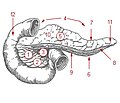Causes of cancer pain: Difference between revisions
CSV import Tags: mobile edit mobile web edit |
CSV import |
||
| Line 32: | Line 32: | ||
[[Category:Pain management]] | [[Category:Pain management]] | ||
{{medicine-stub}} | {{medicine-stub}} | ||
<gallery> | |||
File:Gray82.png|Causes of cancer pain | |||
File:Illu_pharynx.jpg|Causes of cancer pain | |||
File:Illu_pancreas_duodenum.jpg|Causes of cancer pain | |||
File:Gray770-en.svg|Causes of cancer pain | |||
File:Chemotherapy_bottles_NCI.jpg|Causes of cancer pain | |||
</gallery> | |||
Latest revision as of 04:55, 18 February 2025
Cancer pain can arise from a variety of sources, significantly impacting the quality of life of patients. It is a complex phenomenon that can be acute or chronic, and its management requires a comprehensive understanding of its underlying causes. This article aims to elucidate the various causes of cancer pain, emphasizing the importance of accurate diagnosis and effective treatment strategies.
Etiology of Cancer Pain[edit]
Cancer pain can be classified based on its etiology into two main categories: pain caused directly by cancer and pain related to cancer treatment.
Direct Causes[edit]
Direct causes of cancer pain occur as a result of the tumor pressing on bones, nerves, or other organs in the body. The severity of pain can vary depending on the type and stage of cancer. Key direct causes include:
- Tumor Growth: As tumors grow, they can exert pressure on surrounding tissues, leading to pain. This is particularly common in cases where tumors invade bone (osteosarcoma) or compress nerves (neuropathic pain).
- Metastasis: Cancer that spreads (metastasizes) to other parts of the body can cause pain in the new area, such as when breast cancer spreads to the bones or when lung cancer spreads to the brain.
- Blockage: Tumors can block the passage of bodily fluids, causing pain. For example, a tumor in the gastrointestinal tract might block the passage of food, leading to severe abdominal pain.
Indirect Causes[edit]
Indirect causes of cancer pain are associated with treatments and other non-tumor related effects. These include:
- Surgery: Post-operative pain is common and can be acute or chronic, depending on the extent of the surgery and the individual's pain tolerance.
- Chemotherapy: Certain chemotherapy drugs can cause peripheral neuropathy, leading to painful sensations in the hands and feet.
- Radiation Therapy: While effective in killing cancer cells, radiation can also damage healthy tissue, leading to pain and discomfort.
- Hormone Therapy: Used primarily in cancers that are hormone-sensitive (like some breast and prostate cancers), hormone therapy can cause joint and muscle pain.
Pathophysiology[edit]
Understanding the pathophysiology of cancer pain involves recognizing the complex interplay between inflammatory, neuropathic, and ischemic pain mechanisms. Cancer cells can release chemicals that stimulate nociceptors, leading to inflammatory pain. Additionally, tumors can cause direct nerve damage, resulting in neuropathic pain. Ischemic pain occurs when tumors affect blood supply to tissues, causing pain due to lack of oxygen.
Management[edit]
Effective management of cancer pain requires a multidisciplinary approach, including pharmacological treatments, physical therapy, psychological support, and, in some cases, surgical interventions. Pain management strategies are tailored to the individual's specific needs and the underlying cause of the pain.
Conclusion[edit]
Cancer pain is a multifaceted issue that significantly affects patients' lives. Understanding the various causes of cancer pain is crucial for developing effective treatment plans. With appropriate management, the quality of life of cancer patients can be greatly improved.
-
Causes of cancer pain
-
Causes of cancer pain
-
Causes of cancer pain
-
Causes of cancer pain
-
Causes of cancer pain




